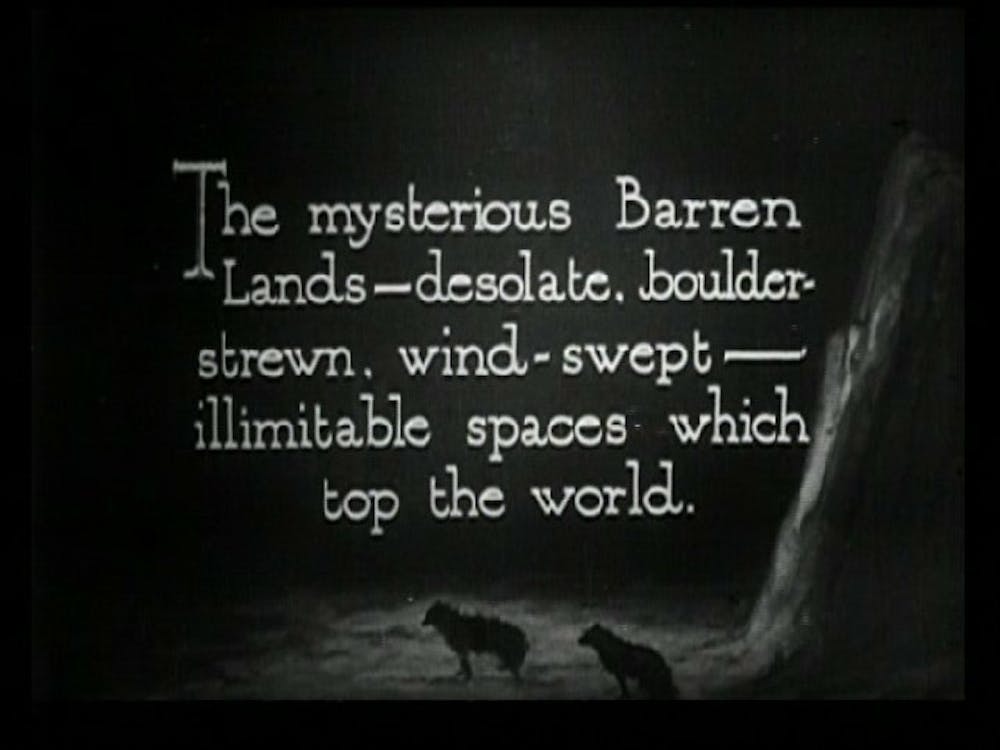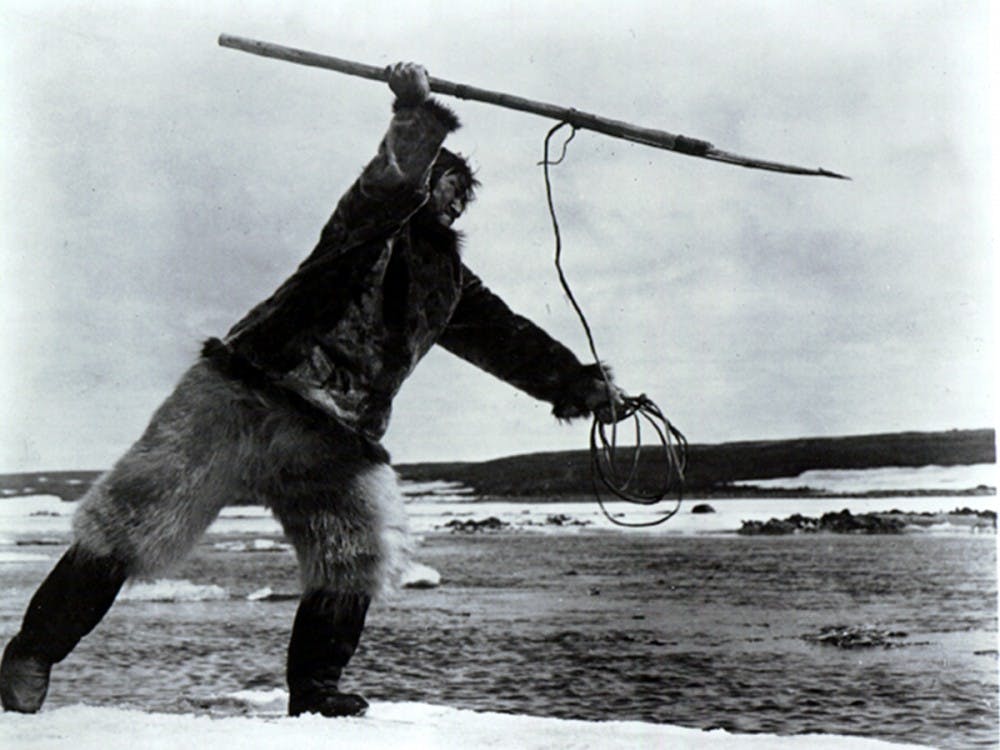As I discussed last week, short, primitive documentary films have existed for some time, but it wasn’t until 1922 that the first feature length documentary was born. Robert Flaherty’s Nanook of the North is somewhat similar to modern travel documentaries: a filmmaker embarks on a quest abroad and films the local residents to detail their culture and customs. Unlike these modern docs, there is no host explaining the events onscreen, well at least not in physical form. Title cards inform the viewers what is happening, not dialogue. In fact, there is no dialogue! Just title cards and background music. What fun.

Don’t fret modern viewer, the film isn’t as boring as you would think. Don’t get me wrong, it’s not exactly a thrill ride, but it does have some interesting qualities.
There really isn’t a “story” per say. Instead the film advertises itself as an exclusive view of the day-to-day life of an Inuit man, named Nanook, and his family. The point of the film isn’t to tell an interesting narrative but to show how difficult surviving in the Canadian Arctic can be. Though dangerous and remote, themes that showcase the beauty of the wilderness as well as familial love and codependency are present.
“Wow!” You may be thinking, “A documentary in 1922 that presents non-white, non-Americans in a good light? That sounds really progressive!”
I hate to be the bearer of bad news, but no. Nanook of the North is a disingenuous film. Yes, it established the feature length documentary as a genre. Yes, it showcased a non-western culture. Yes, it does attempt humanize Nanook and his family in some respects. Those are all good things.
Sadly all of these positive attributes become muddied by scenes that are purposely staged to make the Inuit people appear more primitive to Westernized audiences. Now to be fair, staging does have a place in documentary film, in fact it is often a necessary component. The problem is that Nanook of the North was created before documentary ethics were established. We now know that when reenactments are done to disclose that what is being shown is not an actual portrayal, be it in the film description on the box or through some lower third on screen. While not every documentary is ethical and there are definitely examples of blurring reality and fiction in modern documentaries, there is an expectation of truth.
Flaherty did not have this modern standard to go by, resulting in scenes with questionable presentation. One that stuck out to me is Nanook and his family leaving a canoe to go to a trading post. This is a simple enough premise, but the way the scene is shot presents the family more like clowns exiting a tiny car than a family embarking on a trip.
Okay, not a big deal right? After all, it’s very likely that multiple people did have to fit into one canoe resulting in some funny imagery. Doesn’t this make them more human, more relatable? Well I disagree, but sure, I see your point.
But let’s look at this scene of Nanook hunting a seal. It is definitely made to make Nanook into some Charlie Chaplin-esque comedy character.
And let’s not forget the gramophone scene (excuse the poor video, it’s the best I could find):
Isn’t it cute? Nanook has never seen that newfangled invention before! Only, that’s a lie. The man playing Nanook knew what a gramophone was.
Even the beginning of the film sets up Nanook as a child-like, inferior being by referring to him as the “happy-go-lucky Eskimo”.

Probably the most egregious lie told by the documentary are the subjects themselves. Nanook himself is a lie! His real name is actually Allakariallak and his “family” are actually the wives of Flaherty himself! That is an irredeemable, despicable misportrayal on Flaherty’s part, considering the film was marketed as the true experiences of Nanook and his family.
These examples are all definitely not ethical by today’s standards, but what about simple reenactments? A commonly debated aspect of the film involves Flaherty’s construction of an igloo for filming. The actual igloos built by Nanook didn’t provide enough light for interior filming. Keep in mind cameras were much more limited in the early 1900s, so it is fair to get a bit creative. Flaherty had half of an igloo constructed, with one side exposed to the outdoors allowing for natural light. The igloo was then dressed to look authentic. Is this an example of poor documentary ethics? No, this is a harmless set construction done in many documentaries today. It is unreasonable to expect on-site filming in every situation.
Obviously Flaherty’s point wasn’t to give an accurate-in-depth look into a culture’s lifestyle. Nanook of the North feels more like a docudrama, which is problematic for many reasons. The false portrayals make Nanook seem like a primitive being, something Western audiences can observe similar to animals in a zoo. They don’t emphasize with Nanook, they are entertained by his antics.
With all of this in mind I pose this question: Is Nanook of the North worthy of praise today? Roger Ebert, one of my personal heroes and renowned film critic, offers us this:
The film is not technically sophisticated; how could it be, with one camera, no lights, freezing cold, and everyone equally at the mercy of nature? But it has an authenticity that prevails over any complaints that some of the sequences were staged. If you stage a walrus hunt, it still involves hunting a walrus, and the walrus hasn't seen the script. What shines through is the humanity and optimism of the Inuit. -Roger Ebert
I strongly disagree. Yes, for establishing the documentary genre and at least attempting to capture the lives of a foreign culture, Flaherty does deserve praise. Similarly, some of the shots really demonstrate the savage beauty of the wilderness and give us a glimpse of just how hard survival can be. The scene showing the construction of an igloo is truly mesmerizing to watch and certainly stands out in this regard.
But the film is also condescending, largely based on falsities, and purposefully manipulates its audience. No Mr. Ebert, the walrus scene is definitely problematic in its portrayal. Do you really want to sit there and tell me Nanook stumbling around dramatically wasn’t influenced by the director? That was a purposeful choice to make Nanook a sort of funny racial caricature. If that isn’t enough I’ll simply reiterate: Portraying the film as non-fiction then having the director’s own wives act as the main subject’s actual family is completely inappropriate. I truly don’t see how many of these directing choices can be labeled as “authentic”.
Many herald Nanook of the North as a historic marvel, and it certainly deserves mention and studying in film classes, but I think it deserves more criticism than praise. After all, how many people probably saw this film and based all of their knowledge on the Inuit people off of the false information shown?
For a lesson in documentary history and footage can be manipulated to portray people and stories in ways that fit a director’s agenda, Nanook of the North is well worth a watch. Just don’t expect it to be completely ethical or accurate. I also highly recommend watching Nanook Revisited, a 1990 documentary which outlines all of the staged events and misrepresentations in Nanook of the North. Good luck finding it, the only copies I’ve been able to track are VHS tapes at local libraries.
Ready for more documentaries? Ready for more old documentaries? No? Well you’re in luck. For those of you that like film history, don’t worry. After February we’ll jump back into older films, but for the next few weeks we are going to celebrate Black History Month! Join us next week for one of my favorite documentaries, Through a Lens Darkly.
Images: YouTube, Metal Culture
For more entertainment related content, visit us at Byte Bsu!



















